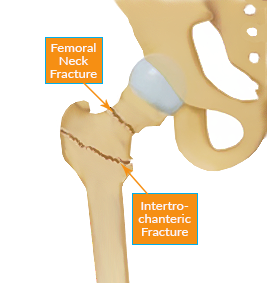Hip Fracture
What is a Hip Fracture?

Hip fractures are very serious injuries that need immediate medical attention. It can be life-threatening. As we age, our risk for a hip fracture rises.
Due to osteoporosis (bones weakening), hip fractures become more and more common in the elderly. Occurring most commonly in those over the age of 60. One of the most common causes of a hip fracture is trip and falls. These typically happen in those taking certain medications. These medications cause poor vision and imbalance. Therefore being more susceptible to experience a hip fracture.
It’s unfortunate, however, hip fractures typically require surgical repair or replacement. Thereafter, physical therapy is often administered.
Symptoms of a Hip Fracture
When a slip or fall happens there are some tell signs of a hip fracture. Those symptoms include:
- Inability to move immediately after a fall
- Severe pain in your hip or groin
- Stiffness, bruising and swelling in and around your hip area
- Shorter leg on the side of your injured hip
- Turning outward of your leg on the side of your injured hip
- Inability to put weight on your leg on the side of your injured hip
Causes of a Hip Fracture
Although hip fractures are more common in those over the age of 60, anyone can experience one. However, it’s only common from severe impacts, such as a car crash.
As mentioned previously, the elderly are most likely to encounter a hip fracture from a trip and fall. In people with weak bones, this can even occur from simply twisting a leg.
Risk Factors
The risk of a hip fracture increases with:
- Age. Bone density and muscle mass tend to decrease with age. Older people also may have problems with vision and balance.
- Your sex. About 70 percent of hip fractures occur in women. However, men also can develop dangerously low levels of bone density.
- Medications. Cortisone medications (such as prednisone) weaken bone if you take them long-term. Also, certain drugs or combinations make cause dizziness. Making someone more prone to falling. Drugs that act on your central nervous systems are most commonly associated with falls.
- Chronic medical conditions. Endocrine disorders, such as an overactive thyroid, can lead to fragile bones. Intestinal disorders, which may reduce your absorption of vitamin D and calcium, also can lead to weakened bone and hip fractures. Medical conditions that affect the brain and nervous system, including cognitive impairment, dementia, Parkinson’s disease, stroke, and peripheral neuropathy, also increase the risk of falling.
- Physical inactivity. Weight-bearing exercises, such as walking, help strengthen bones and muscles. This makes falls and fractures less likely. Those who don’t participate in weight-bearing exercises may have lower bone density and weaker bones.
- Nutritional problems. Lack of calcium and vitamin D in your diet when you’re young lowers your peak bone mass and increases your risk of fracture later in life. Serious eating disorders, such as anorexia nervosa and bulimia, can damage your skeleton by depriving your body of essential nutrients needed for bone building.
- Tobacco and alcohol use. Both can interfere with the normal processes of bone-building and maintenance, resulting in bone loss.
Diagnosing a Fracture
A doctor can often determine if your hip injury is a fracture by simply examining you. However, an x-ray will confirm the location of the fracture and severity. Although, sometimes an MRI will be necessary.
It’s typical for hip fractures to commonly occur in one of two places, the femoral neck or the intertrochanteric region. The femoral neck is located in the upper portion of your femur, just below the ball and part of the ball-and-joint socket. The intertrochanteric region is a little farther down from the actual hip joint and in the portion of your upper femur. Although several more types of fractures are possible, these are the two most common.
Hip Fracture Treatments
When a hip fracture occurs, treatment typically involves surgery, physical therapy and medication.
Surgical Options:
- Internal repair using screws. Metal screws are inserted into the bone to hold it together while the fracture heals. Sometimes screws are attached to a metal plate that runs down the femur.
- Total hip replacement. Your upper femur and the socket in your pelvic bone are replaced with prostheses.
- Partial hip replacement. If the ends of the broken bone are displaced or damaged, your surgeon may remove the head and neck of the femur. Then install a metal replacement (prosthesis). However, partial hip replacement may be recommended for adults who have other health conditions or cognitive impairment.
OUR DOCTORS
Hip Specialists
Our teams of qualified and skilled physicians provide a personalized experience in a caring and comfortable environment to enhance the quality of life of our patients. Utilizing the latest medical technologies and treatments, our staff are committed to delivering convenient and valuable services to meet the needs of the community.
